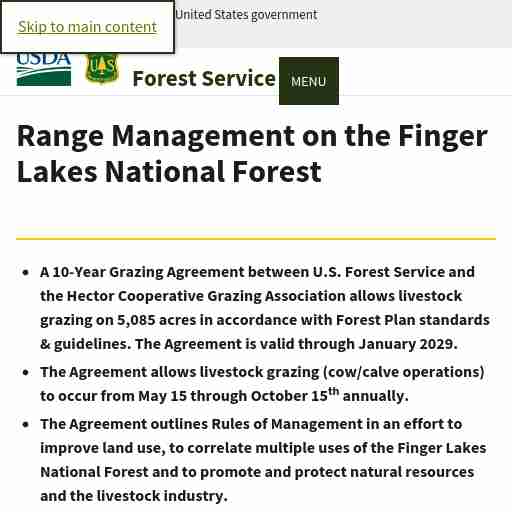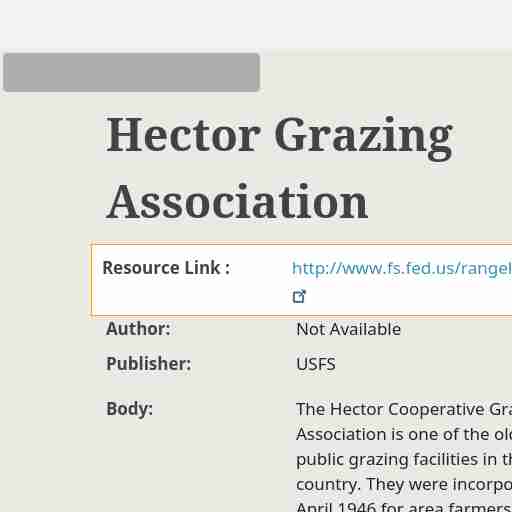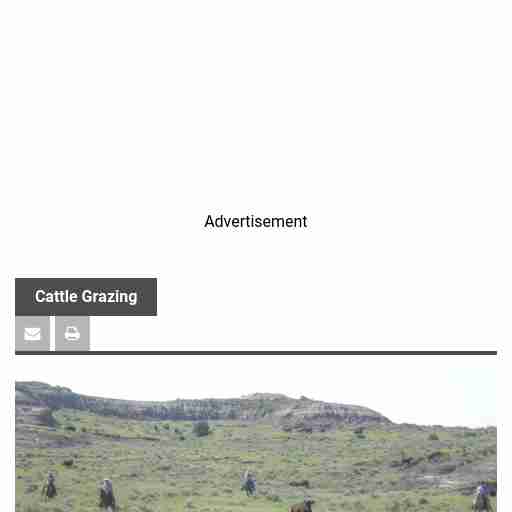
The Hector Cooperative Grazing Association is one of the oldest public grazing facilities in the country. They were incorporated in April 1946 for area farmers, ... An official website of the United States government Range Management on the Finger Lakes National Forest A 10-Year Grazing Agreement between U.S. Forest Service and the Hector Cooperative Grazing Association allows livestock grazing on 5,085 acres in accordance with Forest Plan standards & guidelines. The Agreement is valid through January 2029. The Agreement allows livestock grazing (cow/calve operations) to occur from May 15 through October 15th annually. The Agreement outlines Rules of Management in an effort to improve land use, to correlate multiple uses of the Finger Lakes National Forest and to promote and protect natural resources and the livestock industry. Grazing fees charged by the Association include the annual fee charged by the Forest Service plus additional costs by the Association for operation, maintenance, and other costs of livestock management (i.e. ear tags, salt, care of injured animals, rounding up stock at end of year. Approved conservation improvements done in grazing areas qualify for credits toward the annual grazing fee paid by the Association to the U.S. Forest Service. Hector Cooperative Grazing Association Finger Lakes National Forest, New York The Hector Cooperative Grazing Association is one of the oldest public grazing facilities in the country. They were incorporated in April 1946 for area farmers, who utilized 1,700 acres of grazing land of the State of New York. From 1939 through 1971, the cooperative made use of other resources of the land by harvesting timber, cutting and selling posts, leasing hay lots, and cutting and selling Christmas trees and firewood.

The Hector Cooperative Grazing Association is one of the oldest public grazing facilities in the country. They were incorporated in April 1946 for area ... The Hector Cooperative Grazing Association is one of the oldest public grazing facilities in the country. They were incorporated in April 1946 for area farmers, who utilized 1,700 acres of grazing land of the State of New York. From 1939 through 1971, the cooperative made use of other resources of the land by harvesting timber, cutting and selling posts, leasing hay lots, and cutting and selling Christmas trees and firewood. In 1941, sheep were the primary livestock grazed by the Co-op. The cattle included both beef and dairy and small herds of horses. The initial numbers of members were 138 but dropped to 64 in 1992. Currently, there are 35 dues paying members. Cattle seek shade on a hot summer day.Today the Association grazes 4,500 acres with 35 pastures and 80 miles of fence. The Association is administered under a one-term grazing permit and manages the allocation of the cattle to the members. The Association provides the greatest flexibility and ease of management of the Finger Lakes National Forest.(source introduction). Articles, citations, reports, websites, and multimedia resources focused on rangeland ecology, management, restoration, and other issues on American rangelands. UA College of Agriculture and Life Sciences UA School of Natural Resources and the Environment UA Natural Resources Law and Policy Center Western Association of Agricultural Experiment Station Directors (WAAESD) University of Arizona (UA) CALS Communications & Cyber Technologies (CCT) All contents © 2023 Arizona Board of Regents
---

Jun 21, 2023 ... Hector Cooperative Grazing Association ... Cooperative grazing isn't restricted to states known more for ranching, but also spreads to other ... The Horse Creek Cooperative Grazing Association is made up of six producers who graze over 1,000 cattle on private and public land. Photo provided by Betty Steen. Cooperative grazing associations preserve their role in the beef industry Finding reasonably priced summer grass for cattle can be a challenge, but some farmers and ranchers have long since grouped together in grazing cooperatives, both to help support the profitability of their livestock and to protect and maintain the land. Renting, leasing or purchasing grassland is often a complicated and expensive proposition. While many options are available, not all are practical or realistic. For some farms and ranches, grazing cooperatives have long been an answer to this predicament and are intertwined in the normal management practices of their members. Let’s take a look at a few of these grazing cooperatives and how they’ve allowed producers to support each other and the land from which they make their living. Grand River Co-op Grazing Association Grand River Co-op Grazing Association, located in northwestern South Dakota, provides pastureland for 90 members holding deeded ground with connected grazing permits. The association owns about 14,000 acres, mixed in with 155,000 acres of national forest grasslands. Patrons run 15,000 cattle, largely cow-calf pairs alongside a handful of yearling and sheep operations. Most of the 57 different pastures hold commingled ownership groups. Defined management rules cover everything from capacity limits to weed and pest control to fencing. Leasing agreements with the U.S. Forest Service are renewable every 10 years.
---